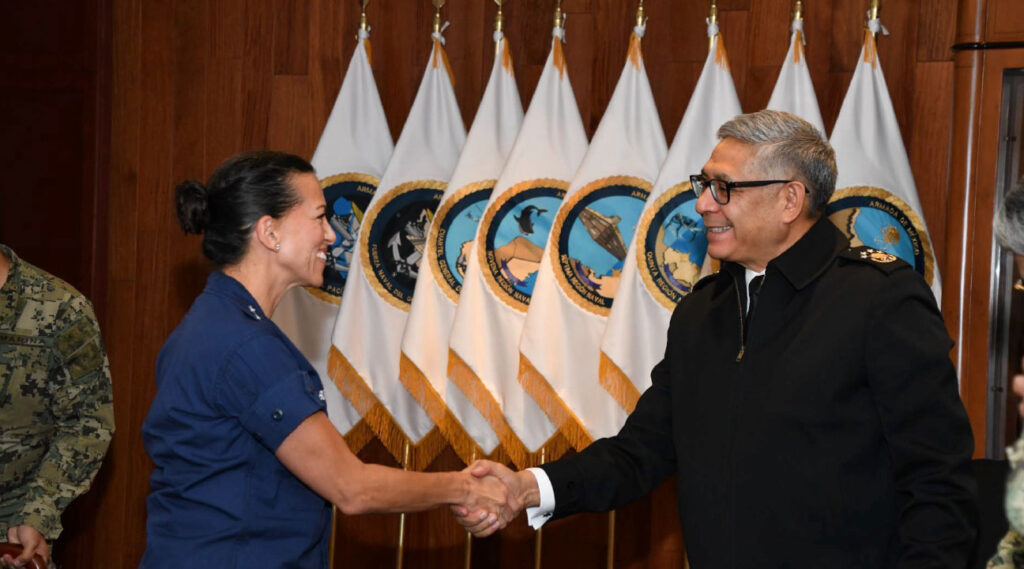Secretaría de Marina Adm. Raymundo Pedro Morales Ángeles receives JIATF-South Director Rear Adm. Jo-Ann Burdian at MARINA Headquarters. MARINA
MAJ. MICHAEL SWINDLE/JOINT INTERAGENCY TASK FORCE SOUTH
A quiet truth is asserting itself in strategic conversations about homeland defense: Mexico and the United States are more than neighbors. They are bound by a shared security interest neither can afford to ignore. The relationship is not regarded with the reverence of more celebrated alliances, like the U.S.’s “special relationship” with the United Kingdom but in terms of regional security, it may be even more vital.
While public perception lags behind this reality, the defense and security community has no such luxury. It already is deep in the work of making it succeed. In that spirit, U.S. Coast Guard Rear Adm. Jo-Ann Burdian, director of Joint Interagency Task Force South (JIATF-South), traveled to Mexico in April 2025 for a series of high-level engagements. Timed ahead of the Central American Security Conference (CENTSEC), her visit affirmed the operational and strategic alignment between two nations.
JIATF-South plays a central role in transforming regional cooperation into coordinated action. With a mission focused on detection and monitoring (D&M) to support interdiction of illicit aerial and maritime trafficking, the task force serves as a connective node across U.S. military, law enforcement, and interagency partners and their international counterparts. Its primary effort, Campaign Martillo, is a multinational operation designed to deny freedom of movement within the Joint Operating Area to transnational criminal organizations (TCOs) and criminal terrorist organizations (CTO). Under Burdian’s direction, JIATF-South has aligned its efforts with evolving regional priorities. Mexico’s engagement is not only central to sustaining operational momentum, it also is critical to the response to emerging threats across both domains.
In a series of engagements at the U.S. Embassy in Mexico City in March and April 2025, Burdian advanced both strategic alignment and operational cooperation. Her meeting with acting Chargé d’Affaires Silvio Gonzalez focused on strengthening Mexico’s military capacity and, in follow-up discussions with members of the Embassy’s Country Team, on sustaining counternarcotics operations amid resource constraints. She also conferred with U.S. Navy Capt. Jose Gomez, senior defense official and defense attaché, to assess surveillance posture and explore deeper cooperation with the Mexican Navy.
The strength of any defense partnership is measured not in sentiment but in operational alignment, and Burdian’s engagements with Mexico’s senior air and maritime leaders offered a clear expression of that imperative. That imperative guided her engagement with Mexico’s top naval leader, Secretaría de Marina Adm. Raymundo Pedro Morales Ángeles, in a wide-ranging discussion of strategic and operational priorities. The meeting set the stage for follow-up discussions with his key staff about enhancing tactical interoperability, including the use of Blue Force Trackers, Identity Intelligence Operations, and addressing Gulf and Caribbean maritime threats. Together, they affirmed the centrality of maritime cooperation in the broader regional security picture.
The air domain presented its own challenges and its own opportunities for alignment. At Secretaría de la Defensa Nacional (DEFENSA) headquarters, Burdian met with Brig. Gen. Víctor Hugo Lozano García, deputy commander of the Centro Nacional para la Protección y Vigilancia del Espacio Aéreo, to discuss the regional air threat, the value of multilateral air operations and expanding U.S.-Mexico integration through Cooperative Situational Information Integration. The professionalism and resolve of Mexican military personnel were acknowledged as central to these efforts. As with every meeting, the message was clear: Collaboration isn’t optional — it is foundational.
Burdian’s visit to Mexico reaffirmed what defense and security professionals on both sides of the border already know: Real partnership is measured not in rhetoric but in shared action. The strength of the Mexico-U.S. security relationship lies in its daily application across all domains and across military, diplomatic and law enforcement boundaries. In the lead-up to CENTSEC, the message was unmistakable: Defending our respective homelands depends on partnerships that are already at work. The next chapter of regional security will not be written by policy alone but by the shared resolve of partners who understand what’s at stake and choose to meet it side by side.

